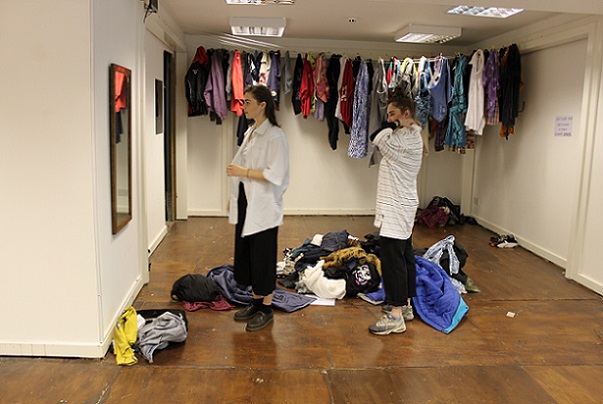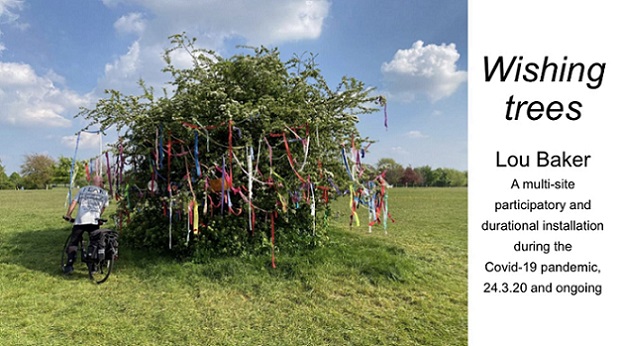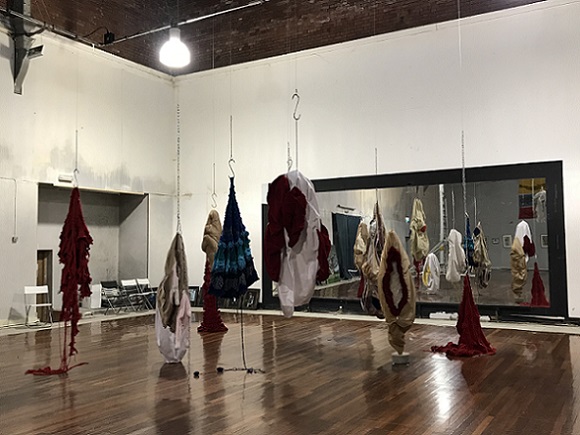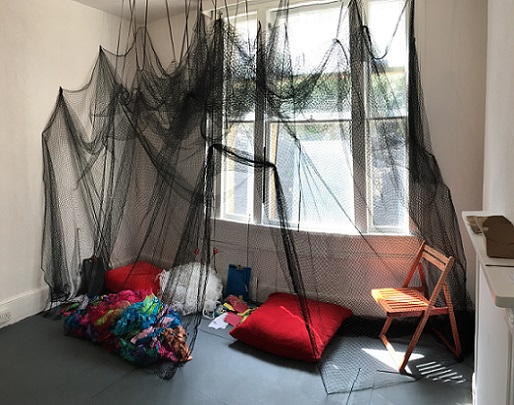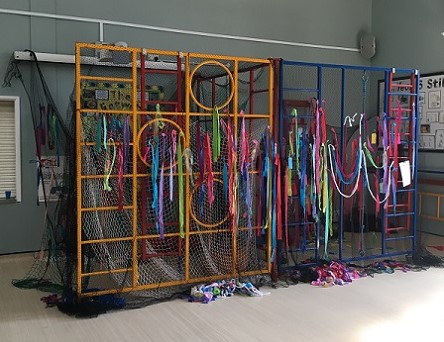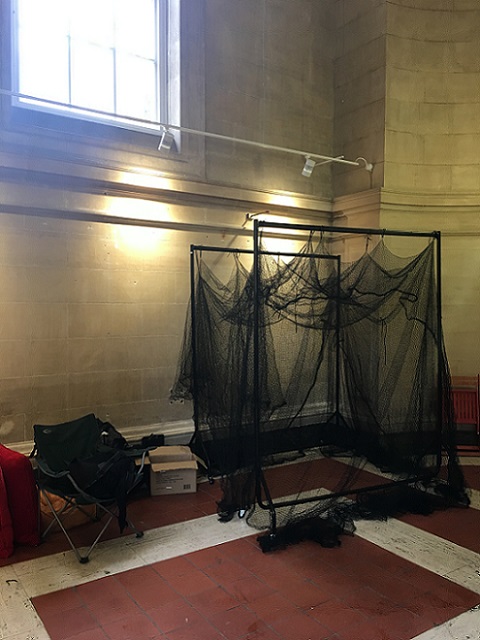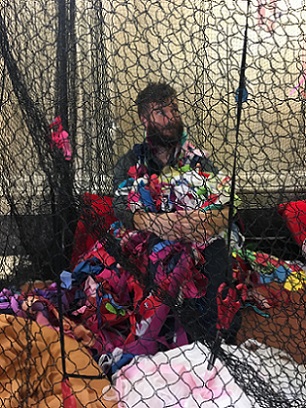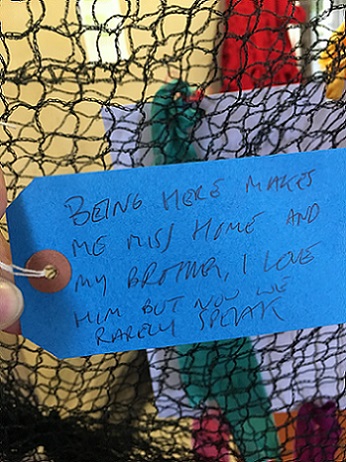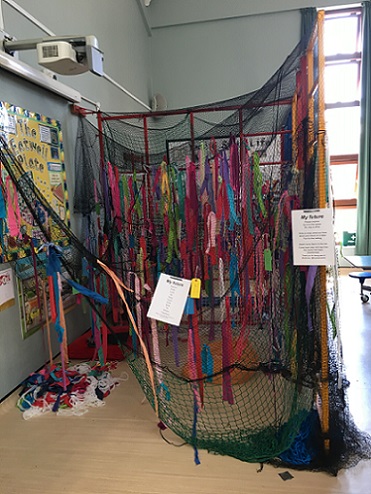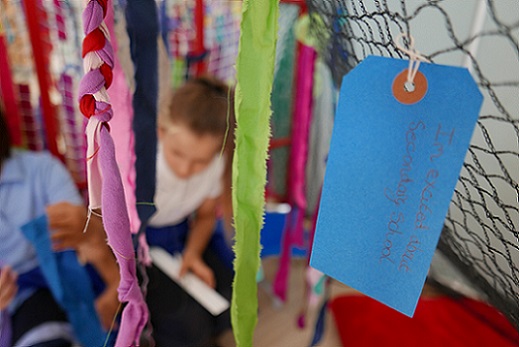*For details of my socially engaged projects and further information, please scroll down*
Have a look at my profile on Issuu as well. You'll find a number of publications there documenting my participatory and socially engaged work.
The beginnings of a socially engaged practice?
The Tate website defines socially engaged practice as ‘art that is collaborative, often participatory and involves people as the medium or material of the work. It's also referred to as social practice or socially engaged art, can include any artform which involves people and communities in debate, collaboration or social interaction. This can often be organised as the result of an outreach or education program, but many independent artists also use it within their work.
The participatory element of socially engaged practice, is key, with the artworks created often holding equal or less importance to the collaborative act of creating them.
Socially engaged practice can be associated with activism because it often deals with political issues. Artists who work within this field will often spend much time integrating into the specific community which they wish to help, educate or simply share with. The artists’ aim could be to help this community work towards a common goal, raise awareness and encourage conversation around issues, or perhaps to improve their physical or psychological conditions.’
Tate, date unknown, Socially engaged practice, Available from: http://www.tate.org.uk/art/art-terms/s/socially-engaged-practice
As I have described elsewhere, I have always been a maker, and I still am, but increasingly some of my work has a socially engaged element.
Safety net at Synecdoche's [dis]place residency at The Vestibules, Bristol, September 2017 (Scroll down for further details and more images.)
What I call my accidental introduction to social engagement happened in 2015. I was awarded The Embroiderers’ Guild Scholarship so was invited to exhibit at The Knitting and Stitching Shows in London and Harrogate. These are large trade shows for everything to do with textiles, with an art gallery area; this is where I was exhibiting. I was expected to be there with my work from 10-5 every day for 9 days in total.

Do you mind if I write that down? at The Knitting and Stitching Show, London, October 2015 (Scroll down for further details and more images)
I was, frankly, rather nervous about exhibiting in this context as I thought that most visitors would want to see traditional, decorative, beautiful, benign textile art and my large, body like soft sculptures are far from that! I had planned to sit quietly and knit and try to avoid any awkward interaction but I realised, almost straight away when I saw how people were responding, that if I did I’d miss an amazing opportunity to engage with my audience. So began the most wonderful few days. I had to make myself quite vulnerable as my work is very personal but I found it cathartic to talk to people who had had similar experiences. There were hugs, tears, lots of laughter and many stimulating conversations about life, and art. There were also some people, inevitably, who disapproved, or couldn’t understand what I was doing, or couldn't see the point, but that was all part of the diverse range of responses.
And I wrote down what people said. I knew I wouldn’t be able to remember everything so I captured what I could in a sketchbook. It was very interesting to see how people responded when I said ‘Oh! Do you mind if I write that down?’ It seemed to validate what they were saying and most people then elaborated and wanted to say more. It was an astonishing experience! I have written more about it further down this page and when I describe my experience during my clothing installation, Don't wash your dirty laundry in public in September 2016.
Have a look at the documentation of the comments and conversations from the Knitting and Stitching Shows, which I have called, appropriately, ‘Do you mind if I write that down?’
I was addicted! I subsequently began to think of ways to involve the public more actively in my work. Have a look at the other projects on this page. I see this as a beginning. I still have a lot to learn about social engagement, but I do find it very exciting! I’m looking forward to finding opportunities to expand this part of my practice further. Watch this space!
Don't wash your dirty laundry in public
at Synecdoche's Bodies residency
in an empty shop in a busy shopping centre in Bristol, September 2016 https://www.youtube.com/watch?v=Jbc0Ru5JGd4 (Scroll down for further details and more images)
2020
Wishing trees, 4 participatory installations situated in public spaces (Horfield Common, The Downs, Purdown and outside my house) in Bristol during the Coronavirus lock down, 24th March and ongoing
For more information click on the image above and visit my MA Fine Art Research website.
2019
Living sculptures, prison series at B-Wing, Shepton Mallet Prison, 21.9-6.10.2019
Feedback cell, at B-Wing, Shepton Mallet Prison. 21.9-6.10.2019
Tethering our thoughts at Incendiary, Stroud Valleys Artspace(SVA), Stroud, Feb 6th -10th
Have a look at my documentation of Tethering our thoughts. It includes the ideas behind the installation, the set up, responses from participants and my reflections on the experience.
Click on the image above or have a look at it here.
Tethering our thoughts is so dynamic that there are also a number of videos:
1. Me talking about Tethering our thoughts
2. Walk into Tethering our thoughts, Day 2
3.Tethering our thoughts, Day 2, moving in the wind I
4. Tethering our thoughts, Day 2, moving in the wind II
5. More moving fruit nets, Day 2
6. Walk into Tethering our thoughts, Day 5
7.Tethering our thoughts, Day 5
8.Tethering our thoughts, Day 5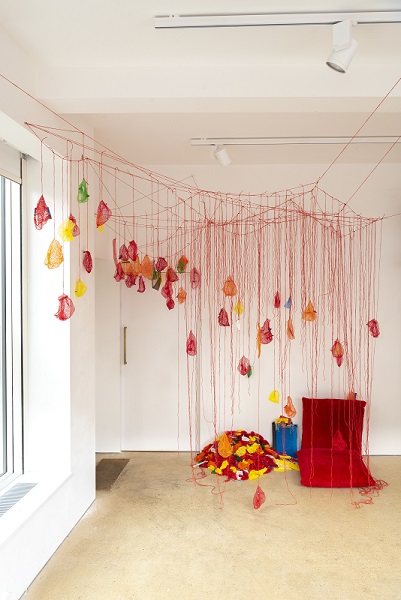
Tethering our thoughts at Incendiary, Day 1
Tethering our thoughts is a site-responsive installation made with red string. I loved making it. It was magical, like drawing in space or stitching the room! It was utterly absorbing. It’s my favourite kind of work; repetitive actions with plenty of intuitive decisions making it very meditative as well. I quickly entered that state of flow, where time flies. Bliss!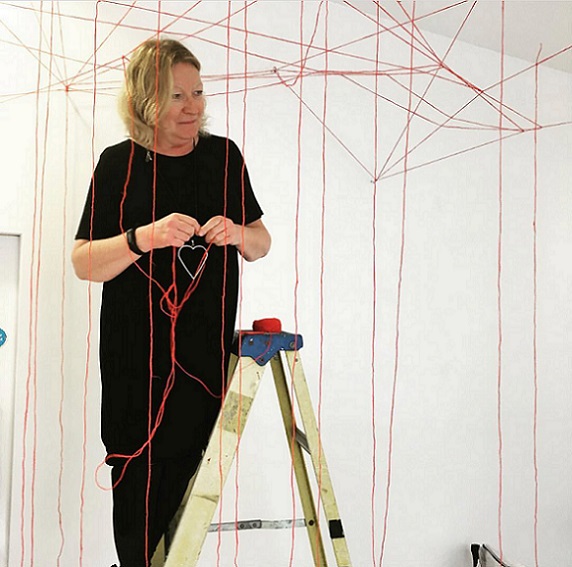
I especially enjoyed the unexpected ways that the string behaved. At times it looked as if the string were creating spontaneous drawings alongside my considered ones. The ends of string where I knotted the vertical strands created distinctive, self-supporting marks in space. I found it mesmerising. Next time I want to stitch a whole room!
Incendiary was a multi-site exhibition ‘responding to the firing of industrial incinerators and combustion fallout on human and more than human ecosystems.’ It was curated by Patricia Brien. For more details and images of the whole exhibition, see my Exhibitions page.
The focus of Incendiary at SVA was ‘Waste’.
As well as being a drawing in space, my installation, Tethering our thoughts, was interactive. The viewer was invited to become an active participant by adding fruit nets to the structure and by writing their thoughts about waste on a label and tying that to the installation too.
'Tethering our thoughts
an invitation to participate:
Please touch.
Walk into the space.
Sit, stay a while.
In the UK, we use about 20 times more plastic than we did 50 years ago
and only 1/3 of that plastic is recycled.
We send over 15 million tonnes of waste from our homes to landfill every year
and much of that ends up polluting landscapes, rivers and seas.
Write your reflections about
waste on a label.
Tie it to the installation.
Add some fruit nets to the structure.
Post photos on social media.
Come back and see how the space has been transformed.
Thank you for being part of #tetheringourthoughts #incendiaryexhibition #incendiary #waste @SVA__
@loubakerartist #loubakerartist'
I added cushions, clipboards, pens and labels so that visitors could sit and reflect inside the space, if they wanted to and left the installation to work its magic.
Why the title, Tethering our thoughts? Louise Bourgeois describes drawing as a way she tethered her thoughts. I consider this installation to be a form of drawing or mark making - with string, fruit nets and labels! I also wanted the installation to become a collective tethering of thoughts about waste, almost ritualistic, symbolic somehow of the power of the few to instigate change, a form of art activism.
And why fruit nets? Maybe slightly strangely, I’ve been collecting fruit nets for several years. They fascinate me. They retain a sculptural form even when they’re empty – a ghost-like trace of their former shape, a memory. For me, they become oddly alluring and strangely ethereal when they’re suspended. They are transformed. However, they are actually also a significant yet insidious part of the plastic problem. They’re ubiquitous and they cannot be recycled. I still find them weirdly compelling and I will reuse my collection in my work but I’m definitely going to stop buying fruit in them from now on!
On Day 2, I decided to remove the cushions, clipboards and labels. When I had proposed the installation, I had expected the space inside to be more distinct, a place to sit and reflect, but actually it wasn’t, possibly because it was so close to the door. I think that this decision changed the work quite significantly for the better. It became much more aesthetically pleasing and more sublime without the visual distractions of the functional elements. It was site responsive, so needed to be adaptable to whatever space it was in. The clipboards, labels and pens were still available nearby, however….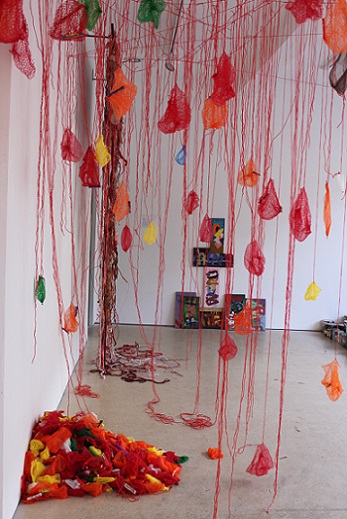
One unexpected delight is that being by the open door made the fruit nets and string move with every gust of wind. It was captivating! The string also created more spontaneous drawings which changed as the wind blew and as people interacted with the space.
On Day 2 I also added some more string, partly to make the installation more dense, but also because it was addictive. I wonder what it would be like to set up an installation like this as a durational performance? I’d love to do that…..
I added some labels with my own reflections about waste to the installation too. I saw them as provocations, a way to start the conversation…
I wasn’t in the gallery every day, but, when I was there, it felt like a great privilege to see the different ways people responded to the space and to talk with them about my work but also about issues surrounding waste. The reflections written on the labels also offer an alternative, poignant and accumulative response to the installation.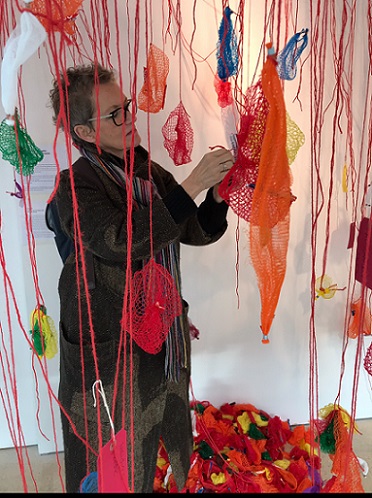
I really liked the fact that some people made their own sculptures with multiple nets and some wove or stitched the nets with the string.
I loved the way that each interaction was different and each changed the installation in some way. Each day was different and over the 5 days of the exhibition the installation was transformed. It became a collaborative piece. Each engagement influenced how the next person responded. It had momentum....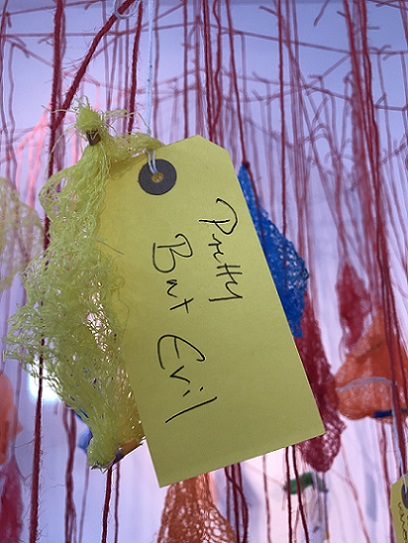
For more responses to the installation, more photos and my reflections please have a look at my documentation of Tethering our thoughts.
My dream is to set up a similar but much larger, walk-in participatory installation elsewhere and for it to be in situ for much longer. How would it change over time? I’d also like to be there all the time, to change the space myself, to engage with participants and also to document their responses and the ways in which the structure would change with time. Maybe I could use CCTV or time lapse photography as well?
Tethering our thoughts, Day 5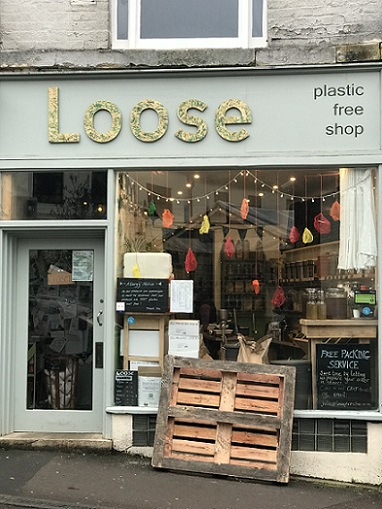
I also set up a tiny satellite installation in the local plastic free shop, Loose.....
As a result of Tethering our thoughts at Incendiary, I have a number of aspirations:
1. Reduce the single use plastic in my life, one area at a time
2. Set up a similar installation somewhere else for much longer
3. Stitch a whole room!
Many thanks to everyone who participated in Tethering our thoughts, to the curator of Incendiary, Patricia Brien, to SVA for hosting us and to all the other artists I met and worked with during the exhibition.
Watch this space!
2018 Living sculptures, a participatory installation at disquiet exhibition, Walcot Chapel, Bath, Sept. 18th -23rd
I was very pleased to have the opportunity to trial some of my Living sculptures for the week of disquiet exhibition at Walcot Chapel. I decided to just install the new, brightly coloured, hand knitted sculptures. There are 6 of them so far, knitted in vivid colours – green, turquoise, blue, orange and two pink ones. One of the pink ones is like some kind of head piece, so I hung the two together. 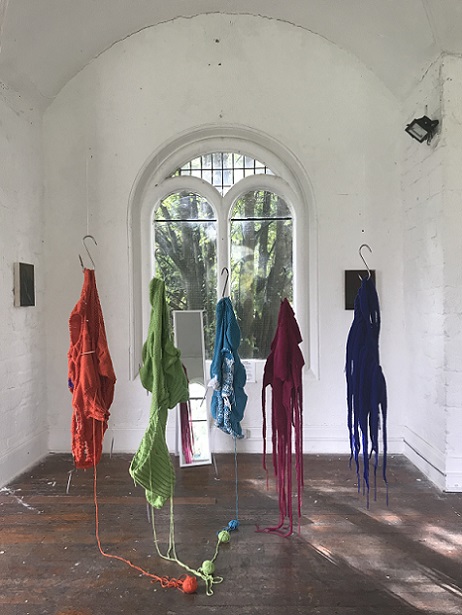
Each sculpture is potentially wearable. Some are garment-like, in that they have elements that are familiar as clothing –sleeves, cuffs and collars - but there the similarity to standard clothing ends! Some have more than two sleeves, some are not like clothing at all. They are abstract soft sculptures, and visitors are invited to wear them. Some of them still have knitting needles and balls of yarn attached. I could carry on knitting them or they could be unravelled….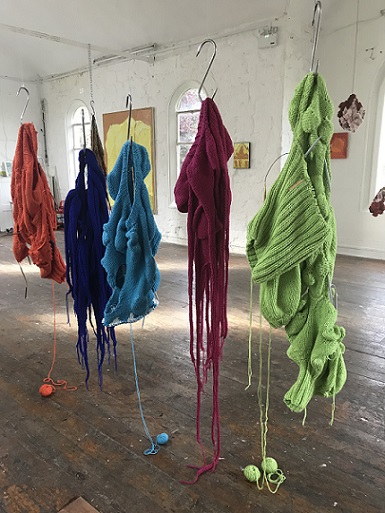
I hung the sculptures from 5 meat hooks so that the sculptures look as if they were suspended in mid- air. Some of them touched the floor, some of the balls of wool sat on the floor. I provided a mirror and an invitation to participate…..
I loved the ways that different people responded to the invitation and to the sculptures! Some people were embarrassed and didn’t want to engage, others quickly became absorbed. Please have a look at the full documentation of Living sculptures, including the research behind the concept, many images and my reflections. It also includes material from the Living sculptures day at Bristol Museum (see below) in July 2018.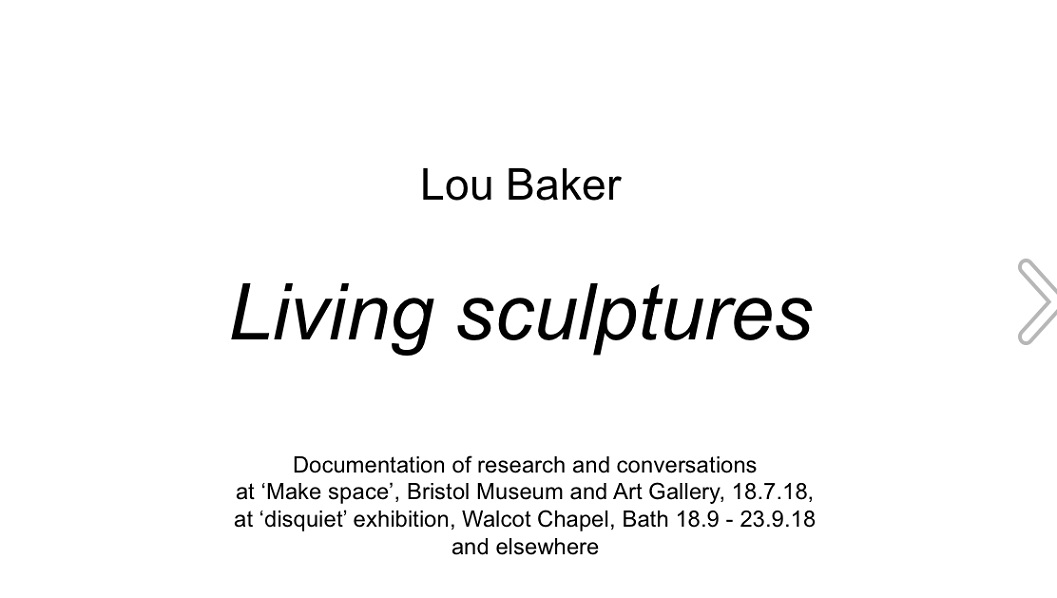
To view the documentation of Living sculptures, click on the image above.
Here are some fabulous videos of Living sculptures in action:
1. Living sculptures, knitted series
2. Living sculptures, trying them on
3. Living sculptures, green
4. Living sculptures, together
5. Living sculptures, twirling
6. Living sculptures, friends
7. Living sculptures, dancing
I have also written more about it on my Exhibitions page, and you'll find more photos there too. I've written more specifically about making the work on my Knitting page.
I feel privileged to have had the opportunity to talk to so many lovely people who willingly engaged with me and my work, allowing me to take photos and videos. Many thanks to all those who took part.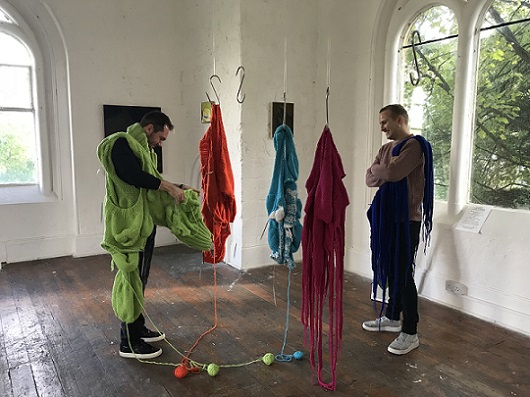
I feel that these pieces are interesting as more static sculptures as well as wearable ones. Hanging them on meat hooks, I think, adds a frisson of something unexpected. Apart from seeing visitors interacting with the pieces. I also really enjoyed the fact that each time they’d been worn and replaced on the hooks, they would take a different form. Sometimes they would be put on a different hook too, so it was an ever-changing installation in more ways than one.
I soon realised however, that using meat hooks in this way is potentially a risk. As soon as a sculpture is taken off a hook, it leaves a very sharp, moving point at face level! With just a few sculptures and being present throughout, I was able to make sure that no one hurt themselves, but for a more immersive installation, with more sculptures, I’ll need to find a different way of suspending the sculptures.
I am hoping to develop this idea further, to make different kinds of more readily wearable soft sculptures and to set them up as an immersive experience.
2018 Living sculptures at Make space, Bristol Museum and Art Gallery, 18th July
Living sculptures is an interactive, participatory installation of wearable, hand knitted and stitched soft sculptures. Normally, in an art gallery, there are signs saying ‘Do not touch’; what happens if the viewer is not only encouraged to touch but is invited to become a living sculpture by wearing an abstract soft sculpture? What would it look like? How would it feel?
I trialed the participatory aspects of this idea as part of a day at Bristol Museum’s Make Space alongside The Woman’s Hour Crafts’ Prize exhibition on 18th July 2018. I invited my visitors to become living sculptures by trying on a soft sculpture, or several!
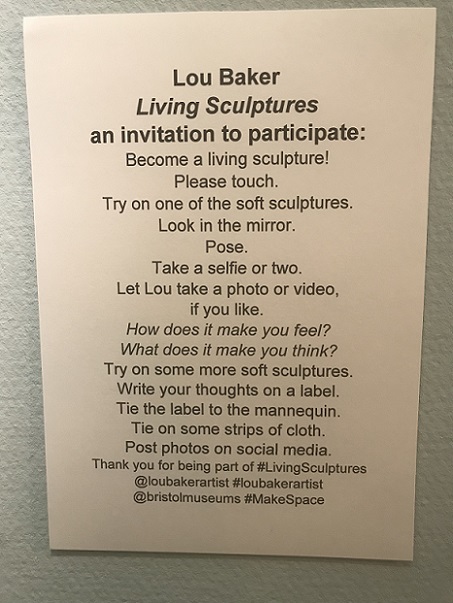
An invitation to participate!
I set up the Make space room, making the new, more wearable sculptures easy to access along with some of my original soft sculptures which can also be worn.
My first stitched, wearable soft sculpture, Living sculpture, furry.
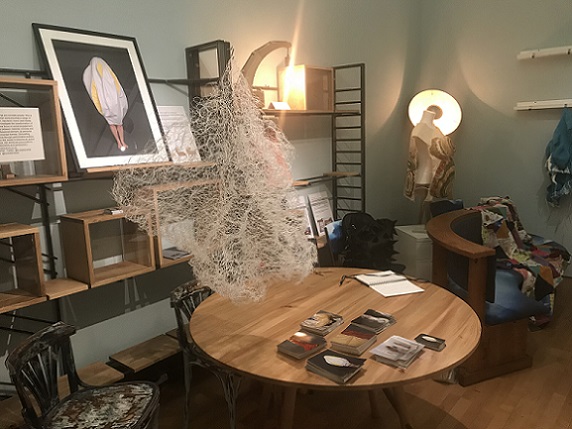
Part of the Make space, set up with a number of my soft sculptures, including the Living sculptures.
Have a look at this video walk through of the space at the beginning of the day. I rearranged it later in the day so that it looked like this.
I documented the event with photos, videos and interactive feedback. It was wonderful. I especially loved the conversations I had and the fabulous ways that people moved when they were wearing my work. It’s clear that the participants found it playful but also thought provoking. Many thanks to those who took part!
Here's a video of one of the participants wearing Living sculpture, furry. I love the way she starts rocking! This visitor started spinning as soon as she put on No animals have been harmed in the making of this garment, this lady began to dance and so did this one as soon as she put on Heart of darkness I!

One visitor exploring Living sculptures.
Identity is often communicated through the clothes we wear, but, at a deeper level, the multiple selves we reveal to the world can conceal our true sense of self. Living sculptures investigates this disconnect.
Another visitor wearing The whole is greater than the sum of the parts.
Most of my static soft sculptures are technically wearable, and at some point during the process of making, I try on all my sculptures. It’s part of making them me and is also part of my ongoing research into the links between clothing, body and identity. Yet they are, realistically, utterly unwearable. Have a look at the wonderful, quirky images of me wearing them, Wearing the unwearable.
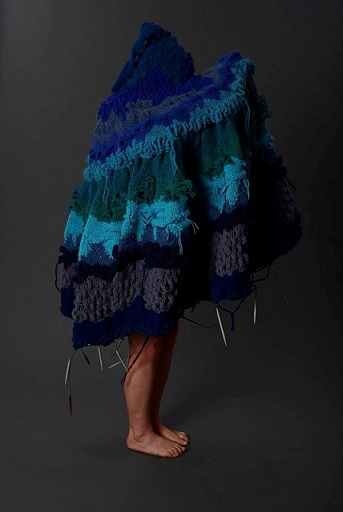
Me, wearing Nobody 3.
Living sculptures is the beginning of a larger body of work in progress where, using traditional garment-making skills and unexpected materials, I am developing a selection of more readily wearable sculptures which can be put on and removed independently by visitors. I am merging my making with my social engagement! The passive viewer can choose to become an active participant, a performer; or, for the onlooker, the space will be transformed into a dynamic, ever-changing, interactive experience.
Carl Jung describes individuation as the process of finding meaning in life, and ultimately of finding our self. It involves balancing our multiple selves with the dark side, or shadow, of ourselves; failure to acknowledge and accept this shadow can result in fragmentation and associated mental health issues. Exploring this sense of being ‘other’, Living sculptures offers the viewer the opportunity to take on various temporary identities by trying on a selection of bizarre, handmade, wearable soft sculptures. 
My youngest visitor enjoying wearing No animals have been harmed in the making of this garment!
Encouraging participants to post selfies on social media provides valuable feedback, documentation of the experience and extends the project’s reach. This playful, interactive art adventure interrogates the boundaries between self and other, changes the balance of power in the gallery setting and questions the true value and authorship of art.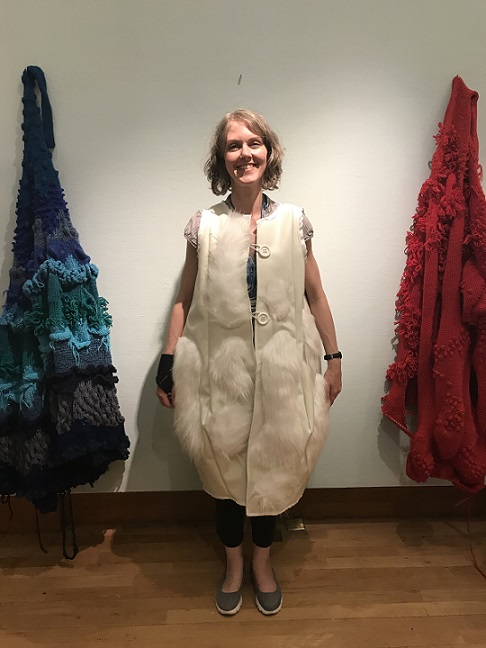
Have a look at a delightful video of this participant wearing Living sculpture, furry!
The sculptures also make an intriguing static exhibit. They have garment-like elements, but are clearly not functional clothes. They can be exhibited it any number of ways – on hooks, hangers, clothing rails, suspended from meat hooks, displayed on mannequins…. The list is endless. They could also be exhibited alongside photos of some of the wonderful participants who have worn them!

My new knitted series of Living sculptures.
The Living sculptures day at Make space was very valuable to me. Not only was it hugely enjoyable, but it was also very useful as research and I was able to gather some interesting feedback, both oral and written, about the experience. I’m now planning to add to this series and provide further opportunities for a larger, more immersive experience. I envisage a room full of my hanging soft sculptures, maybe like the installation at the PRILIC exhibition, amongst which the active participants, the Living sculptures can move. I’m looking forward to developing this idea further, maybe using CCTV to record and play back the visitors’ interactions with the sculptures.
Update, October 2018: Have a look at the research and documentation of the Living sculptures project so far, including a week at 'disquiet' exhibition at Walcot Chapel, Bath in Sept 2018.
A room full of my hanging soft sculptures at PRILIC, Jacob's Wells Baths, Bristol, Dec 2017
For more about the works in progress, have a look at my knitted Living sculpture, pink, blue, orange, turquoise and green and my new stitched Living sculpture, furry.
Here are more photos of the Make space and more of the wonderful images of the Living sculptures being worn:
1. Make space at Bristol Museum and Art Gallery
2. Living sculptures: an invitation to participate
3. My first stitched wearable soft sculpture - Living sculpture, furry
4. A series of knitted Living sculptures, displayed in the space
5-10. Views of Living sculptures at Make space
11-26. Some of the wonderful participants wearing the Living sculptures and some of my other soft sculptures
2017
Safety net at Synecdoche's [dis]place residency at The Vestibules, Sept
Safety net at [dis]place is the 3rd iteration of the Safety net idea. The first was part of Refuge: in search of safety at Fringe Arts Bath in May 2017, the second at St. Werburgh’s Primary School in June. At the school it had a different focus as it was part of an Aspiration Day for Year 5s and 6s. There I called it My future. Scroll down the page for more information about both of these installations.
Each time I have set up Safety net it has been very different. At Fringe Arts Bath I was given half a room in a semi derelict shop and I was able to staple the netting to the walls, ceiling and floor. I think this has been the most satisfying set up so far as it felt as if I was sculpting with netting and a stapler and was very intuitive. It was utterly site responsive and has been the most aesthetically pleasing installation so far.
Safety net, Day 1, at Refuge: in search of safety, Fringe Arts Bath, May 2017
At the Primary School the set up was, possibly inevitably, much more limited in that I was asked to set it up over some climbing equipment. It obviously made it into a very different space, but was adequate for the setting and the students responded with curiosity and thoughtfulness. The Safety net concept ticks lots of boxes in terms of accessibility; it’s a provocation, it’s kinaesthetic, and it's differentiated, it will suit different types of learners.
My future at St Werburgh's Primary School, Bristol, Aspiration morning, 6th July 2017
For Safety net at The Vestibules, I knew I wouldn’t be able to use staples as it’s a listed building so I planned to create the netting structure by tying it to a couple of tall garment rails. I found this was much less aesthetically pleasing than the installation at Refuge, but in the circumstances it worked. Each Vestibule was quite an awkward space to use, in some ways, as we had to keep clear gangways from each inner doorway as they were fire exits. We also had to negotiate space between 7 artists.
Safety net, Day 1,5.9.17 at [dis]place at The Vestibules, Bristol, September 2017
My little safety net was dwarfed by the size of The Vestibule though! I would be thrilled to set it up again in that space. Next time I’d see if it could be more sculptural and site responsive and I’d attach it to the infrastructure of the building. I would probably need very tall ladders, or a scaffolding tower, maybe a couple of technicians and definitely the whole space!
The garment rails have wheels and I had planned to wheel the structure outside onto the open public space outside The Vestibules, College Green, on dry days to see what would happen. Needless to say, once the structure was set up, I realised how hard it would be to move it, especially alone, so it didn’t happen. I also became engrossed in my displacement activities and was busy doing other things most of the time.
It’s interesting to compare Safety net at [dis]place with Safety net at Refuge. At [dis]place it was in place for 20 days, at Refuge it was up for 17 days. At Refuge the changes from Day 1 to the end are much more evident. The written responses are similar in both settings, although there were fewer labels and fewer pieces of cloth attached at The Vestibules. I think there are a number of reasons for this. At Refuge, the footfall was much higher, Safety net was the only participatory piece in the exhibition and I also spent some time adding pieces of cloth to the net when I was there as a kind of performance. At Refuge, Safety net was a more private space for reflection because of the way the exhibition was set up. Also the focus of the whole Refuge exhibition was on safety and, as many of the pieces of work on show dealt with troubling issues, it seems to me that some viewers used the labels to reflect on the whole show, not just on Safety net. At [dis]place, on the other hand, we had fewer visitors, there were several other interactive pieces and I decided not to add pieces of cloth this time. Although the focus of the residency at The Vestibules was [dis]place, the ways that the artists interpreted that term were very varied. I also wonder if the set up and aesthetics of the piece at The Vestibules made it less appealing.
One happy participant!
The responses to Safety net at [dis]place were still very positive, nonetheless. I have kept all the labels and at some point I’ll document them, but in the meantime have a look at the record I made of the residency, Displacement activity. It includes some reactions to Safety net as well as the documentation of my other displacement activities. I have also included photos of a number of the labels in the gallery below.
One of the labels tied on to Safety net at [dis]place
Leaving Safety net to do its thing is another example of change in control. I found at Refuge that if I talked to people about their responses to the net they became inhibited, but if I left them to it they would spend more time inside the net and more time reflecting. I hope it’s a non-threatening way to enable the viewer to find their voice, which can be anonymous or not. Sometimes, however, people didn’t want to write, but talked to me instead, so I have scribed some of the labels. This was particularly true of a group of adults with learning difficulties. I was delighted too that the wheeled rails meant that we could expand the entrance and the space so that one of them, a wheelchair user, was able to go inside!
Inviting the viewer to write a label is also a very useful, and hopefully not too intimidating, way to get feedback on the work. Feedback by stealth?
Safety net, a private space for reflection?
Another change in control is how the structure changes with each interaction. Apart from setting it up, tidying the space from time to time, taking photos and occasionally talking to people about it, I did nothing and yet with each added piece of cloth or label the space changed. It’s hard to categorise this piece of work and it raises a number of possibly unanswerable questions. It’s obviously an installation, it's site responsive, it’s participatory and interactive but should it also be called a collaboration? Is it social engagement? I see myself as the facilitator, but the idea is mine, so I am also the artist. But are the participants artists too? Co authors?
Friends who work in Early Years education call this a provocation; apparently that’s a thing with pre-schoolers. I think it’s a fitting term for my work as well.
Safety net at [dis]place, Day 18, 28.9.17
An unexpectedly poignant aspect to Safety net has been the deconstruction of the net each time. Taking it down the first time, after Refuge, I only had time to bundle the nets into a bag, with the labels and cloth strips attached, and bring it home. Have a look at a video of me bundling the nets into a bag. On reflection it became clear that it’s temporal and site-dependent too, a transient piece, so it no longer has an identity when it’s no longer in situ. I think this makes it especially poignant; it is the setting and accumulation of interactions that make it what it becomes. As a time- and site-responsive piece, inevitably the documentation is critical. Keeping the piece intact defeated the object, it needs to be a blank canvas in each new setting and so I began to unravel the cloth and untie the labels….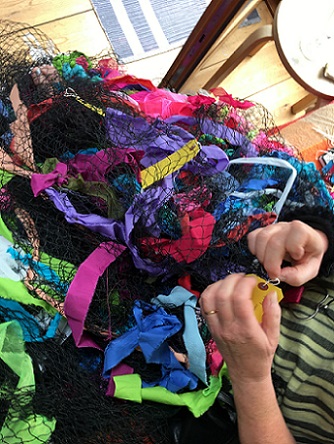
Beginning the long, slow process of unravelling Safety net
Making work can be cathartic and satisfying and ‘un making’ can be similarly therapeutic. This work was repetitive, time-consuming and oddly reflective as each time I did it with a group of friends and we read the labels to one another as we untied them. It felt strange though to be undoing the effort of others, but also like part of the circle of life. It makes me think of the myth of Penelope who wove by day and unravelled by night....
And what is left each time? 2 unadorned pieces of garden netting, with traces of coloured threads still attached, three bin liners of strips of coloured cloth and a pile of responses on labels. It seems appropriate that most of it can be recycled and significant that a safety net is so transient….
However it is defined, Safety net does seem to be an effective way to enable people to reflect and respond to a particular subject. I’m looking forward to having opportunities to set it up again in different spaces and contexts, maybe with a different title and focus.
Gallery of images of Safety net at [dis]place:
1-7. Day 1, 5.9.17: Sculpting with netting, elastic and two garment rails!
8. Day 1, 5.9.17: Safety net at [dis]place
9. Day 2, 6.9.17
10-12. Day 3, 7.9.17
13-27. Day 4, 8.9.17
28. Day 6, 12.9.17: How small Safety net seems!
29, 30. Day 8, 14.9.17
31-33. Day 9, 15.9.17
34-39. Day 10, 18.9.17
40. Day 12, 20.9.17
41. Day 13, 21.9.17
42, 43. Day 16, 26.9.17
44. Day 17, 27.9.17
45, 46. Day 18, 28.9.17
47, 48. Day 19, 29.9.17 This little boy spent some time inside Safety net with his mum and did some drawings. He wanted to take this yellow label home with him so he could remember the experience!
2017
My future at St Werburgh's Primary School, Bristol, Aspiration morning, 6th July
I was asked to take part in an Aspiration morning for Year 6 students of 5 local primary schools. It was about inspiring the children so that they could find out about different careers. I was there to tell them what it’s like to be an artist. I thought it would be fun (for them and for me!) to set up a version of Safety net, but with a different focus so that the students could be actively involved. I decided to call it My future and invited the students to think about their future and write down one thing they were excited about and one thing that worried them.
My future at St Werburgh's Primary School Aspiration morning
This time I used the moveable climbing frames to make the structure, draping the netting over them to make it den-like. It meant that there were in fact two spaces, which worked well as, at times, there were lots of children who wanted to join in. I don’t think it was as aesthetically pleasing as Safety net at Refuge, (see below), but it worked well in this context.
The students seemed to really enjoy writing or drawing their thoughts on the labels and then attaching them to the netting with the strips of coloured cloth. It was very lovely to see them being engaged - thinking, talking and having fun! I was very grateful to Alice Smith for coming to help. She was especially good at getting the children to talk to her.
'I'm excited about secondary school.'
I still have to document their responses, but predictably, the most common thing the students were excited about was also the thing that worried them – starting secondary school. There were some wonderfully aspirational labels as well!
Here is a video of My Future.
And here is a gallery of images:
2017
Safetynet at Refuge: in search of safety, Fringe Arts Bath, May 26th - June 12th 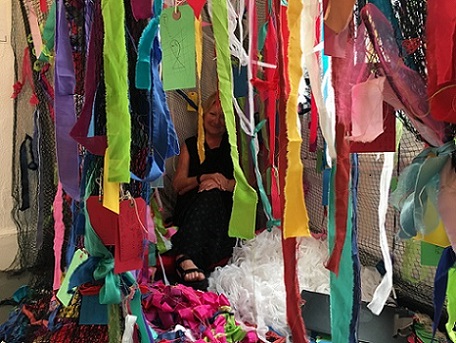
Lou Baker inside Safety net at Refuge, Fringe Arts Bath, Day 17, 12th June 2017
Safety net is a site responsive, temporal installation made with garden netting. At Fringe Arts Bath, I was able to create the piece by stapling it to the walls, ceiling and floor. It definitely felt like drawing or sculpting with netting! The viewer is invited to go in to the den-like space and reflect on safety, and then respond to it by adding strips of brightly coloured, torn cloth to the structure and also writing their thoughts an a label and attaching it as well.
Safety net at Refuge: in search of safety, Fringe Arts Bath, Day 1, May 26th 2017
It was thrilling to see how the installation was transformed from a public place to a more private space over 17 days and how the actions of the participants changed not only the look of Safety net, but the form too. It was thought provoking to read the reflections of the participants - some frivolous, some funny and some very poignant. Have a look at the documentation of Safety net's development over 17 days at 'Refuge; in Search of Safety.'
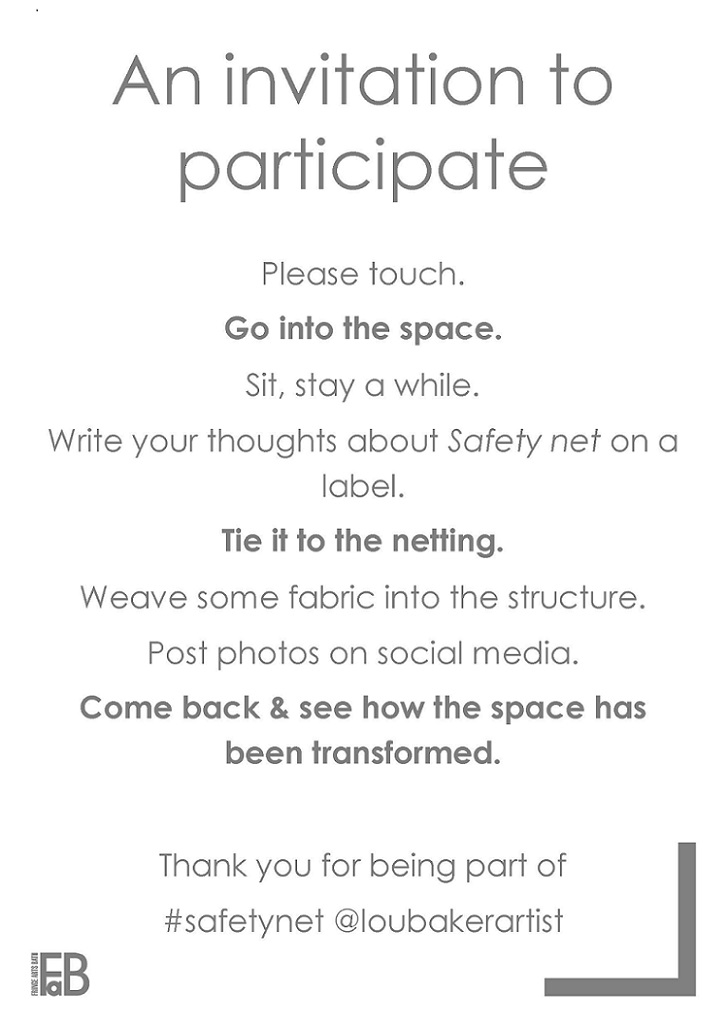
An invitation to participate....
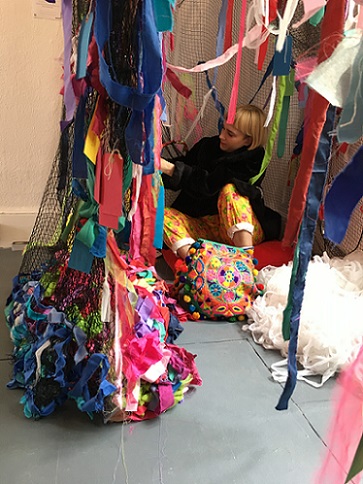
Safety net, Day 12

One visitor came back, bringing her sister, Day 14
Initially, this net structure provides no privacy, no shelter, it’s just a minimal, see-through barrier to the inside. As time passes and the work develops, the accumulation of responses will obscure the inside of the structure and make it a much more satisfactory hiding place or shelter; or will it? As it changes, how will that change the reaction of the viewer? As passive viewer becomes active participant, how will their interaction change the space for others? Inhabiting it, being still there, sharing the space, interacting with the structure; for each person it will be a different experience.

Safety net, Day 15
A seemingly superficial participatory interaction becomes a provocation which explores the liminal space between safety and danger. Where some feel safe, others will feel claustrophobic, where some feel calm, others will feel uncomfortable. It will question our security and make public things that are normally private. It will also give the viewer a glimpse into the experiences of the many people who are forced to live in a world of transient shelters. It will highlight the vulnerabilities and insecurities of an ephemeral resting place.
Is it a trap or a den?'
2016
Don't wash your dirty laundry in public, during Synecdoche's Bodies residency at The Unit, Bristol,
Don’t wash your dirty laundry in public is part of the art work I produced at Bodies: a group residency by Synecdoche. It’s based around a series of temporary installations of used clothing which took place between 1st and 30th September 2016 in an empty shop in a busy shopping area in the centre of Bristol, UK. The space was open to the public for 4 days a week. It took on a life of its own and became part social engagement, part performance but was also participatory, confessional, interactive, and highly conceptual.
Clothing is often thought of as a second skin; it makes us think of bodies. It’s quite unusual to use it in art. It’s soft and impermanent and can remind us of our mortality. It also somehow mixes up the senses of touch and sight. There are strong links with memory too. Clothes, when worn, take on the shape of the wearer and become sculptural. When they are empty, they can suggest absence. Hanging them increases this sense of loss. When the clothing is second hand, other elements come into play, including abjection and contamination anxiety.
I have, essentially, spent a month hanging out the same clothes again and again in different ways in an empty shop, arranging them in body bags, talking to people, writing down their comments and taking photos. The clothes belong to my family and I’ve been giving them away. It has made me feel very vulnerable at times. I have been making public things that are normally private. I am delighted that it has provoked a range of conflicting responses - attraction, repulsion, horror, hilarity, grief, comfort, understanding and incomprehension, amongst others.
Have a look at thepresentation I made at the end of the residency, Don't wash your dirty laundry in public, which documents some of the comments, conversations, photos and reflections on my series of temporary installations of used clothing at The Unit Bristol. Thanks again to everyone who so generously shared their thoughts with me and allowed me to write down their comments and take photographs!
I've also written a blog post with some of my thoughts about the experience. And here is a video of me talking about my work.
#whatdoartistsdoallday
#everydayisdifferent
Gallery of images of Don't wash your dirty laundry in public:
1. Don’t wash your dirty laundry in public, used clothing, shoes, pegs, washing line, hand written title
2. Second hand clothes, mind map accompanying the installations
3. Day 4, 4.9.16 Don’t wash your dirty laundry in public; it begins! Some clothes hung from meat hooks; a pile of clothes and shoes, the FREE CLOTHES sign
4. Day 4, 4.9.16 Don’t wash your dirty laundry in public, members of the public looking at the free clothe
5. Day 4, 4.9.16, one corner with clothes pegged on the washing line
6. Day 6, 6.9.16, with some clothes hanging from hangers at the front
7. Day 6, 6.9.16, two members of the public trying on clothes
8. Day 8, 8.9.16, sagging lines!
9. Day 8, 8.9.16, trying on a t-shirt in front of the mirror
10. Day 9, 9.9.16, unpegging
11. Day 9, 9.9.16, more unpegging
12. Day 9, 9.9.16, a different performance installation
13. Day 11, 11.9.16
14. Day 11, 11.9.16
15. Day 15, 15.9.16, reflection
16. Day 15, 15.9.16
17. Day 15, 15.9.16, rearranging
18. Day 15, 15.9.16, another performance installation, clothes in body bags, still free
19. Day 15, 15.9.16, detail of clothes in body bags in front of the chalk wall
20. Day 16, 16.9.16, members of the public rummaging through a pile of body bags to look at clothing
21. Day 16, 16.9.16, shoes
22. Day 16, 16.9.16
23. Day 16, 16.9.16
24. Day 16, 16.9.16
25. Day 16, 16.9.16, trying on a shirt
26. Day 16, 16.9.16
27. Day 16, 16.9.16, being zipped in to a body bag
28. Day 17, 17.9.16
29. Day 17, 17.9.16
30. Day 18, 18.9.16, a member of the public getting into a body bag
31. Day 21, 21.9.16, tidy shoes, FREE SHOES
32. Day 22, 22.9.16
33. Day 22, 22.9.16
34. Day 23, 23.9.16,another of the many performance installations
35. Day 23, 23.9.16, some of the artists trying on clothes
36. Day 23, 23.9.16
37. Day 25, 25.9.16, BODY PART-y, Don’t wash your dirty laundry in public, final installation
38. Day 25, still from the video of me talking about my work
2016
Tethering our thoughts: a collaboration between Lou Baker, Gina Baum, Helen Acklam, Laura Waite, Maura Zukina, Nicola Pearce, Alice Jennings, at 'Bodies: a group residency by Synecdoche', 24th - 29th September 2016.
In September 2016, 12 members of Synecdoche took over an empty shop in the centre of a busy shopping area in Bristol, UK for a month. It was open to the public for 4 days a week. We set up studio spaces, made work in the space, held workshops and interacted with the public. We called it 'Bodies: a group residency by Synecdoche'.
For most of the month the focus of my work was on Don’t wash your dirty laundry in public, a series of changing installations of my family’s used clothing which I hung out in the space and then gave away. I invited the viewer to try on the clothing and take it away. I also encouraged them to tell me what they thought about the experience, wrote down some of the comments and conversations and took lots of photos. I have documented it here.
Tethering our thoughts, 24th September 2016
Alongside this, I was interested in using the space for a collaboration. I had an idea that some of the artists could work together to make a large scale, participatory, walk in, textile installation. Others were keen, so we planned it, but in fact found that we were so busy with other things that we ended up installing it on Day 24, the day before the closing party.
Its form was site responsive and intuitive. We used garden netting, hooked and stapled to walls and ceiling, for the structure and had cushions inside. We provided a selection of materials to tie and weave into the netting, and a clip board with the question: ‘Trap or den?’ We then started adding to it and encouraged our visitors to join in.
We called the piece Tethering our thoughts as that was what I was reminded of as we set up the tent-like structure; Louise Bourgeois describes drawing as a way to tether her thoughts and we saw this participatory installation as a form of three dimensional drawing.
The response was delightful. Some people came and just sat inside the space on the cushions, some alone and others in groups. Others became absorbed, weaving pieces of fabric, yarn and pipe cleaners into the netting. 
More participants!
1. Materials
2. Planning
3. - 5. Setting up
6. - 12. Participation
13. - 19. Details of the installation
2015
Do you mind if I write that down? My accidental introduction to social engagement, Oct and Nov
In 2015, as Embroiderers’ Guild Scholar, I was invited to exhibit my work as part of The Embroiderers’ Guild Graduate Showcase for 5 days at The Knitting and Stitching Show in London in October and 4 days in Harrogate in November.
Lou talking to a visitor about her soft sculptures
at The Knitting and Stitching Show, London, October 2015
I was, frankly, rather nervous about exhibiting in this context as I imagined that most visitors would want to see beautiful, colourful, benign textile art.
As the show opened I wanted just to sit and become absorbed in my knitting but I quickly realised that if I didn’t actively engage with the public, I’d miss an unprecedented opportunity to get valuable feedback; in a gallery setting the artist might usually only be present for a couple of hours during a private view or when invigilating. In this setting I was with my work from 10-5 for 9 days over the 2 shows.
Because it was so busy and I felt it was very important for me to record the responses of my public, I began to ask people, as we were talking, whether I could write down their comments. And so it began; it hadn’t been planned, but it became something invaluable to me – documentation of the event and the fabulous range of responses to my work mixed in with my reflections of our conversations. 
Just a few of the wonderful responses to my work!
For more, have a look at the full documentation, 'Do you mind if I write that down?'
There was definitely an element of performance in it. My interest in each person’s thoughts and opinions was entirely genuine, and I also made myself vulnerable and discussed private things, but over the course of time, it became performative as I reached for my sketchbook and pen and asked ‘Oh! Would it be OK if I write that down?’ For more about the performative aspects have a look at my Performance page.
In conversation at The Knitting and Stitching Show, London

